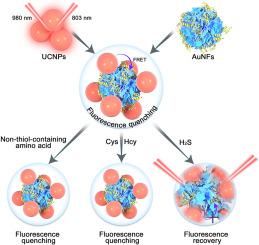Our official English website, www.x-mol.net, welcomes your feedback! (Note: you will need to create a separate account there.)
Synergistic synthesis of gold nanoflowers as upconversion near-infrared nanoprobe energy acceptor and recognition unit for improved hydrogen sulfide sensing
Talanta ( IF 6.1 ) Pub Date : 2024-03-15 , DOI: 10.1016/j.talanta.2024.125908 Hongyu Chen , Peipei Tian , Jiayi Guo , Manman Sun , Wenping Zhu , Zhendong Li , Zengchen Liu
Talanta ( IF 6.1 ) Pub Date : 2024-03-15 , DOI: 10.1016/j.talanta.2024.125908 Hongyu Chen , Peipei Tian , Jiayi Guo , Manman Sun , Wenping Zhu , Zhendong Li , Zengchen Liu

|
A highly sensitive and selective upconversion near-infrared (NIR) fluorescence and colorimetric dual readout hydrogen sulfide (HS) nanoprobe was constructed based on the excellent NIR fluorescence emission performance of upconversion nanomaterials (UCNPs), the specific recognition effect of synergistically synthesized gold nanoflowers (trypsin-stabled AuNFs (Try-AuNFs)) and the effective NIR fluorescence quenching capability. In this assay, the sensing strategy included three processes. First of all, the synthesized UCNPs can emit 803 nm NIR fluorescence when they were excited by 980 nm excitation light. Secondly, as a result of the principle of fluorescence resonance energy transfer (FRET), Try-AuNFs can effectively quench the NIR fluorescence of UCNPs at 803 nm, which can effectively improve the signal-to-background ratio of nanoprobes, thereby improving the sensitivity of the probes. Thirdly, in the presence of HS, the Try protective layer on the surface of Try-AuNFs was specifically penetrated, which will subsequently cleave Try-AuNFs via the strong S–Au bond. As such, the NIR fluorescence of UCNPs will be restored, achieving high selectivity and sensitivity detection of HS. Under optimized conditions, the linear response range of HS was 0.1–300 μM, and the detection limit was 53 nM. It is worth noting that the Try on the surface of Try-AuNFs via the synergistic effect can increase the steric hindrance of the probe, and this can effectively prevent the interaction between the probe with biothiols (cysteine (Cys), homocysteine (Hcy)) and other natural amino acids (non-thiol-containing) with resultant in the high selectivity regarding the detection of HS in human serum, which is unlikely to be achieved by AuNFs synthesized by the gold seed method (Se-AuNFs). This work not only provided a new type of UCNPs fluorescence quencher and recognition unit, but also exemplified that the use of the physical properties (steric hindrance) of protein ligands on the surface of nanoflowers can improve the specificity of the probe. This will provide new ideas for the design of other nanoprobes.
中文翻译:

金纳米花的协同合成作为上转换近红外纳米探针能量受体和识别单元,用于改进硫化氢传感
基于上转换纳米材料(UCNPs)优异的近红外荧光发射性能、协同合成的金纳米花(胰蛋白酶稳定的 AuNF(Try-AuNF))和有效的近红外荧光猝灭能力。在此测定中,传感策略包括三个过程。首先,合成的UCNPs在980 nm激发光激发下可以发出803 nm NIR荧光。其次,由于荧光共振能量转移(FRET)原理,Try-AuNFs可以有效猝灭UCNPs在803 nm处的近红外荧光,可以有效提高纳米探针的信号背景比,从而提高灵敏度的探头。第三,在 H2S 存在的情况下,Try-AuNFs 表面的 Try 保护层被特异性穿透,随后通过强 S-Au 键裂解 Try-AuNFs。这样,UCNPs的近红外荧光就会恢复,实现HS的高选择性和高灵敏度检测。在优化条件下,HS的线性响应范围为0.1~300 μM,检测限为53 nM。值得注意的是,Try-AuNFs表面的Try通过协同作用可以增加探针的空间位阻,从而可以有效阻止探针与生物硫醇(半胱氨酸(Cys)、同型半胱氨酸(Hcy))之间的相互作用。和其他天然氨基酸(不含硫醇),从而对人血清中的 HS 检测具有高选择性,这是金种子法合成的 AuNF(Se-AuNF)不可能实现的。该工作不仅提供了一种新型的UCNPs荧光猝灭剂和识别单元,而且例证了利用纳米花表面蛋白质配体的物理特性(空间位阻)可以提高探针的特异性。这将为其他纳米探针的设计提供新思路。
更新日期:2024-03-15
中文翻译:

金纳米花的协同合成作为上转换近红外纳米探针能量受体和识别单元,用于改进硫化氢传感
基于上转换纳米材料(UCNPs)优异的近红外荧光发射性能、协同合成的金纳米花(胰蛋白酶稳定的 AuNF(Try-AuNF))和有效的近红外荧光猝灭能力。在此测定中,传感策略包括三个过程。首先,合成的UCNPs在980 nm激发光激发下可以发出803 nm NIR荧光。其次,由于荧光共振能量转移(FRET)原理,Try-AuNFs可以有效猝灭UCNPs在803 nm处的近红外荧光,可以有效提高纳米探针的信号背景比,从而提高灵敏度的探头。第三,在 H2S 存在的情况下,Try-AuNFs 表面的 Try 保护层被特异性穿透,随后通过强 S-Au 键裂解 Try-AuNFs。这样,UCNPs的近红外荧光就会恢复,实现HS的高选择性和高灵敏度检测。在优化条件下,HS的线性响应范围为0.1~300 μM,检测限为53 nM。值得注意的是,Try-AuNFs表面的Try通过协同作用可以增加探针的空间位阻,从而可以有效阻止探针与生物硫醇(半胱氨酸(Cys)、同型半胱氨酸(Hcy))之间的相互作用。和其他天然氨基酸(不含硫醇),从而对人血清中的 HS 检测具有高选择性,这是金种子法合成的 AuNF(Se-AuNF)不可能实现的。该工作不仅提供了一种新型的UCNPs荧光猝灭剂和识别单元,而且例证了利用纳米花表面蛋白质配体的物理特性(空间位阻)可以提高探针的特异性。这将为其他纳米探针的设计提供新思路。



























 京公网安备 11010802027423号
京公网安备 11010802027423号